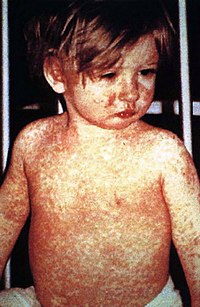
Photo from wikipedia
© BMJ Publishing Group Limited 2023. No commercial reuse. See rights and permissions. Published by BMJ. DESCRIPTION A boy in middle childhood noticed a painful, erythematous papule on his right… Click to show full abstract
© BMJ Publishing Group Limited 2023. No commercial reuse. See rights and permissions. Published by BMJ. DESCRIPTION A boy in middle childhood noticed a painful, erythematous papule on his right index finger near the proximal interphalangeal joint (figure 1A) in the morning upon waking. He was unable to recollect being bitten by an insect. Later that afternoon, a red streak extending from the initial inflammatory papule gradually toward the dorsum of the right hand, wrist and forearm (figure 1B) appeared, prompting a visit to our clinic on the same day. The linear eruption was itchy but painless. He was receiving no medication, and his medical history was unremarkable. On examination, he was in excellent, general condition; he had no fever or lymphadenopathy. The tenderness was limited to the papule. Based on the patient’s history and physical examination findings, superficial lymphangitis resulting from an arthropod bite was clinically diagnosed. He was treated with a topical steroid, but the rash deteriorated by the followup examination on the next day (figure 1C). Oral antihistamine was added to the treatment. The rash and other symptoms improved significantly by day 3 after the initial visit (figure 1D) and resolved by day 4. Lymphangitis is an inflammation of the lymphatic channels manifesting highly characteristic, linear, erythematous streaks. Most cases of acute lymphangitis are caused by group A Streptococcus infection following skin damage. Noninfectious causes are very rare, but secondary, superficial lymphangitis following an arthropod bite is recognised as a benign condition mimicking common bacterial lymphangitis. However, most cases of superficial lymphangitis resulting from an arthropod bite are thought to be misdiagnosed and treated as an infection. Important clinical features distinguishing superficial lymphangitis after an arthropod bite from a bacterial infection include the absence of pain, tenderness, fever, lymphadenopathy and a selflimiting clinical course. Although most patients, including the present one, cannot recall having been bitten by an arthropod, the presence of a tender macule with a haemorrhagic centre is a useful clue to the correct diagnosis. The precise pathophysiology of superficial lymphangitis after an arthropod bite remains unknown but is thought to involve a hypersensitivity reaction to toxins contained in the secretion of arthropods. The injected toxin and inflammatory cells are drained by the lymphatic vessels, causing a linear spread of the inflammation. 5 The treatment, including topical steroids, oral antihistamines and oral corticosteroids, only addresses the symptoms, but antimicrobials are unnecessary. In this case, he was initially treated only with a topical steroid but needed additional oral antihistamines due to the deterioration of his condition, suggesting that early antihistamine administration may potentially be beneficial. Physicians should be aware of
Journal Title: BMJ Case Reports
Year Published: 2023
Link to full text (if available)
Share on Social Media: Sign Up to like & get
recommendations!